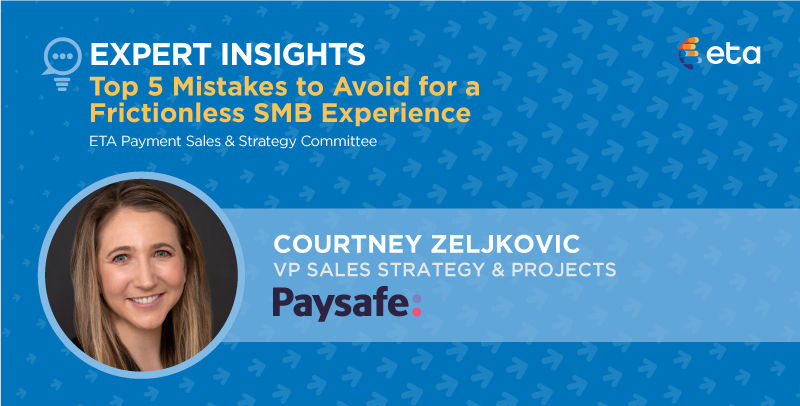ETA Expert Insights: Top 5 Mistakes to Avoid for a Frictionless SMB Experience

By Courtney Zeljkovic, Paysafe
ETA Payment Sales & Strategy Committee
We’ve heard it from our Paysafe sales reps and sales partners, large and small: We need seamless onboarding to compete in the SMB market. The COVID-19 pandemic has only amplified the need for a frictionless, self-service experience, as in-person and paper applications have continued to decline.
Paysafe had an existing self-service application, but the voice of the customers was telling us that there was an even bigger opportunity. So we listened and analyzed the feedback and results to establish our game plan.
To better support our sales teams and partners, we had to decide: Should we enhance our current version, or should we go back to the drawing board and reimagine what self-service could look like? Because we understand the value of the SMB market, and because we want to provide the best possible experience, we opted for the harder path, knowing that we’d get the best long-term outcome.
Designing and developing a brand-new merchant application is no small task. You’ll inevitably encounter numerous mistakes and learning opportunities. Here are the top 5 things I learned during this process:
1. Approach From a Beginner’s Perspective
Do not overlook the importance of knowing your audience and designing this for them. This application is not for you or the payments experts you work with. Pull yourself out of the jargon. This is especially crucial if you’re going after an SMB base, where POS is much more likely to mean “piece of you know what” (and if you don’t believe me, check Urban Dictionary!).
Also, do not assume users know what a “ticket” is, and understand that “terminal” is more likely to evoke images of airports than hardware or ecommerce tools. Be sure to examine every question and term you use from a beginner’s perspective.
Leaders in this space don’t rely on pop-ups with helper text. They ask clear and intuitive questions and offer clear and intuitive response options.
2. Decide if You’re Designing for Mobile or Desktop — And Understand the Difference
If you’re opting for a mobile-optimized experience, stop staring at the application exclusively on your laptop or desktop computer. On desktop, you can get away with fewer screens and more questions per screen.
When it comes to mobile, however, that approach could overwhelm the user. You’ll need to break up the questions over more screens. And if you demo the mobile experience on a computer, be prepared for feedback that there are too many screens!
3. Less is More in Self-Service
There are some obvious foul poles here in terms of risk and compliance, but your focus should be on getting minimal data from the user and putting third-party integrations and AI to work for you.
For example, we opted to integrate with an address-suggestion technology so users can complete their entire address with just a few keystrokes. There are also banking and KYC intelligence technologies, and many other tools, that you can use to protect the user experience and protect your business.
In addition, you can use logic and design to simplify your user experience. As examples, see where you can prepopulate responses, hide nonrequired fields to reduce clutter, and let users select from predefined options or ranges rather than entering in free-form text.
4. Assume Abandonment and Have a Plan B for Sales
There’s no way you’re going to convert every lead that hits your page. It will still be more likely for a user to abandon rather than complete the application in their first session— and the leads that don’t finish cannot just fall on the floor. This is critical for revenue assurance and ROI on your marketing and development.
Consult with your sales and marketing teams on what essential info they need to re-engage users. Get their list of data-points and put those fields sooner rather than later in the application process.
Make sure you also address how your sales and marketing teams (both internal and external) will know when someone abandons purchase. Consider getting your team aligned on email or call campaigns to convert more leads into customers.
5. Take an MVP Approach – Learn Fast and Learn Cheap
While Silicon Valley mantras such as “fail fast, fail cheap, fail often” are pervasive, I much prefer a “learn fast and learn cheap” approach. Imperfection is not failure. You will never launch if your overarching goal is to launch a perfect product. It’s OK — and advisable! — to take an iterative approach. Get something out there to test and refine.
You don’t have to do this blindly. Get user feedback early and often, throughout design, development, and post-launch. Data and analytics are widely available, as are inexpensive tools you can use to see larger user trends and then act on the insight.
In conclusion, your application is one of the earliest impressions you make on your customer. There’s proof of concept and a competitive need for an easy, intuitive merchant onboarding experience. Using these tips, we hope that you get back into the field faster and that your approach is more cost-effective and successful.

